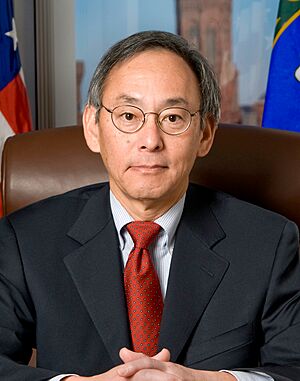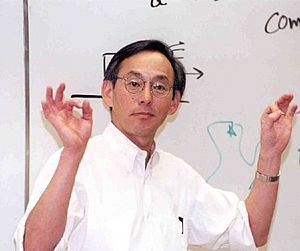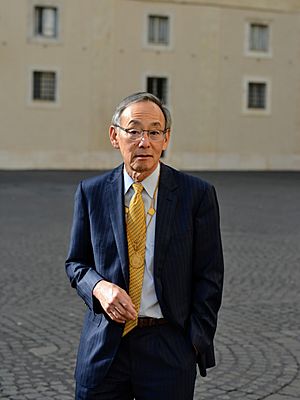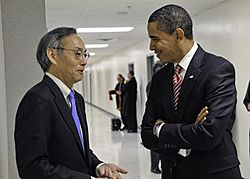Steven Chu facts for kids
Quick facts for kids
Steven Chu
FREng ForMemRS HonFInstP
|
|
|---|---|

Official portrait, 2009
|
|
| 12th United States Secretary of Energy | |
| In office January 21, 2009 – April 22, 2013 |
|
| President | Barack Obama |
| Deputy | Daniel Poneman |
| Preceded by | Samuel Bodman |
| Succeeded by | Ernest Moniz |
| Personal details | |
| Born | February 28, 1948 St. Louis, Missouri, U.S. |
| Political party | Democratic |
| Spouses | Lisa Chu-Thielbar (divorced) Jean Fetter
(m. 1997) |
| Children | 2 |
| Parent |
|
| Relatives |
|
| Education | University of Rochester (BA, BS) University of California, Berkeley (MS, PhD) |
| Profession | Physicist |
| Awards |
|
| Scientific career | |
| Fields | Atomic physics, biological physics, polymer physics |
| Institutions | |
| Thesis | Observation of the Forbidden Magnetic Dipole Transition 62P1/2→72P1/2 in Atomic Thallium (1976) |
| Doctoral advisor | Eugene D. Commins |
| Doctoral students | Michale Fee |
| Chinese name | |
| Chinese | 朱棣文 |
| Hanyu Pinyin | Zhū Dìwén |
Steven Chu is an American physicist and a former government official. He won the Nobel Prize in Physics and served as the 12th U.S. secretary of energy. He is currently a professor at Stanford University.
Steven Chu is famous for his work on cooling and trapping atoms using laser light. He shared the 1997 Nobel Prize in Physics for this important discovery. His research helped scientists study tiny atoms with great accuracy.
From 2009 to 2013, Chu was the U.S. Secretary of Energy under President Barack Obama. In this role, he worked on energy policies for the country. Before and after his time as Secretary, he was a professor at the University of California, Berkeley and Stanford University.
Chu strongly supports renewable energy and nuclear power. He believes moving away from fossil fuels is key to fighting climate change. He has also suggested a "glucose economy" where plant sugars could be used like oil.
Contents
Early Life and Education
Steven Chu was born on February 28, 1948, in St. Louis, Missouri. His family came from China. He went to Garden City High School in New York.
He earned two bachelor's degrees in 1970 from the University of Rochester. One was in mathematics and the other in physics. He then received his Ph.D. in physics from the University of California, Berkeley, in 1976.
Steven Chu comes from a family of highly educated people. His father was a chemical engineering professor. His mother studied economics. His grandfather was a hydraulic engineer and a university president. His uncle was a biophysicist.
His older brother, Gilbert Chu, is a professor at Stanford. His younger brother, Morgan Chu, is a patent lawyer. Many of his family members have advanced degrees in science, medicine, and law.
Career and Research
After getting his doctorate, Steven Chu worked at Bell Labs. There, he and his team did the research that won him the Nobel Prize. They found a way to cool atoms using six laser beams. This method helps scientists study individual atoms very precisely. It can also be used to build very accurate atomic clocks.
In 1987, he became a physics professor at Stanford University. He led the physics department there for several years. At Stanford, he helped start the Bio-X program. This program focuses on combining different science fields to study biology and medicine.
In 2004, Chu became the director of the Lawrence Berkeley National Laboratory. This is a major U.S. Department of Energy research center. Under his leadership, the lab focused on biofuels and solar energy. He started the Helios project to find ways to use solar power for transportation.
Chu's research also expanded into biological physics. He studied how enzymes work and how proteins and RNA fold. He used special tools like optical tweezers to study tiny molecules. He also researched polymer physics using individual DNA molecules.
Awards and Recognition
Steven Chu received the Nobel Prize in Physics in 1997. He shared it with Claude Cohen-Tannoudji and William Daniel Phillips. They were honored for their work on cooling and trapping atoms with laser light.
He is a member of many important science groups. These include the United States National Academy of Sciences and the American Academy of Arts and Sciences. He is also a foreign member of the Chinese and Korean Academies of Sciences.
Chu has received many honorary doctorates from universities. These include Boston University, Washington University in St. Louis, Harvard University, and Yale University. These degrees recognize his important contributions to science and public service.
In 2011, he became an international fellow of the Royal Academy of Engineering in the UK. In 2014, he was made a Foreign Member of the Royal Society. These honors recognize his groundbreaking work in physics and his efforts to solve energy and climate challenges.
U.S. Secretary of Energy
The United States Senate approved Steven Chu's nomination to be Secretary of Energy. He was sworn in on January 21, 2009. He was the first Nobel Prize winner to join the U.S. Cabinet. He was also the second Chinese American to serve in the Cabinet.
In February 2009, Chu visited China. There, he and China's Minister of Science and Technology announced the US–China Clean Energy Research Center. This center works on clean energy solutions together.
Chu continued his scientific work even as Secretary. He published papers on topics like gravitational redshift. In March 2011, he said that regulators should not delay approving new nuclear power plants in the U.S. This was after the Fukushima nuclear disaster in Japan.
In August 2011, Chu supported a report on natural gas development. The report suggested better data collection and stricter standards for hydraulic fracturing. This drilling method helps get gas but raises concerns about groundwater pollution.
Chu resigned as Energy Secretary on April 22, 2013. In his resignation, he warned about the dangers of climate change from using too many fossil fuels. He said, "the Stone Age did not end because we ran out of stones; we transitioned to better solutions."
Energy and Climate Change
Steven Chu has always spoken out for more research into renewable energy and nuclear power. He believes that moving away from fossil fuels is very important to fight climate change and global warming. He has also talked to students about their future role in solving environmental problems.
Chu has warned that global warming could harm farms in California. He joined the Copenhagen Climate Council. This group works to encourage action on climate change.
In 2015, Chu signed the Mainau Declaration 2015 on Climate Change. Many Nobel Laureates signed this declaration. It was given to the President of France to support the COP21 climate summit in Paris.
Chu has suggested a "glucose economy." In this idea, special plants that produce a lot of glucose would be grown in warm places. This glucose could then be shipped around the world, much like oil is today. This could be a way to create a low-carbon economy.
He has also suggested painting building roofs and roads white or light colors. This could help reflect sunlight back into space and reduce global warming. He said this could have a big impact on the environment.
Personal Life
In 1997, Steven Chu married Jean Fetter, who is also a physicist. He has two sons, Geoffrey and Michael, from a previous marriage.
Chu enjoys sports like baseball, swimming, and cycling. He taught himself tennis and pole vaulting when he was younger. He never learned to speak Chinese because his parents always spoke English to their children.
See also
 In Spanish: Steven Chu para niños
In Spanish: Steven Chu para niños
- United States Department of Energy
- Timeline of low-temperature technology
- Energy policy of the United States
- University of Rochester
- List of Nobel Laureates affiliated with the University of Rochester






